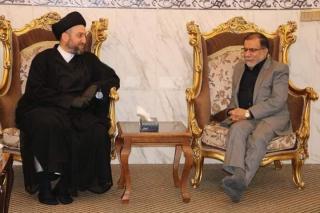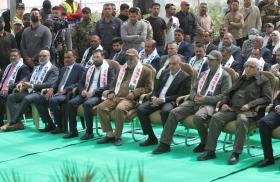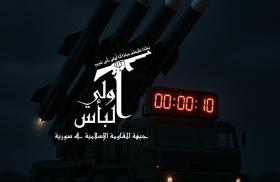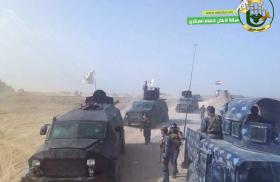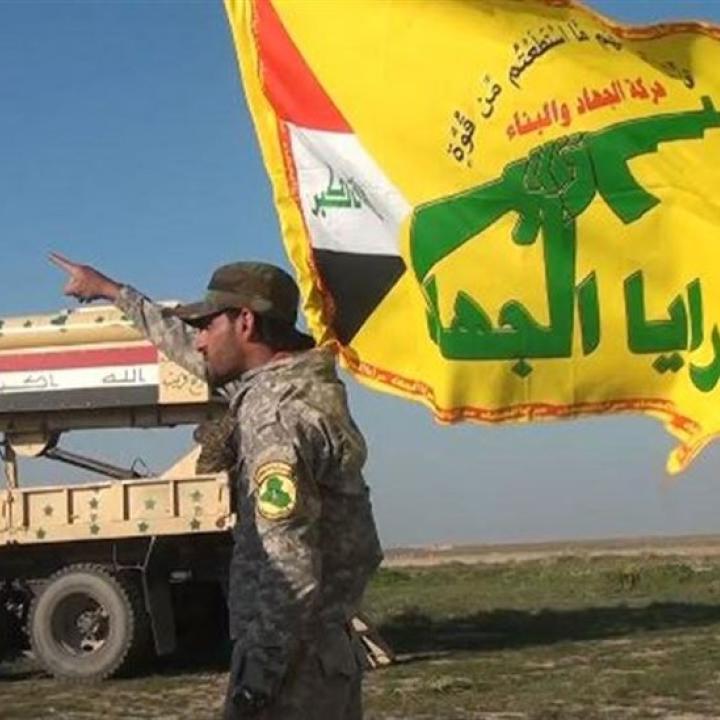
Profile: Saraya al-Jihad

Part of a series: Militia Spotlight: Profiles
or see Part 1: How to Use Militia Spotlight: Profiles
A low-profile Iraqi militia that is deeply linked with Iran's Qods Force and plays important roles in storing advanced conventional weapons provided by Tehran and suppressing Iraqi moderates.
Name: Saraya al-Jihad (Jihad Brigades, or SJ).
Type of movement: Political, armed (fasail), and social group. Full spectrum of kinetic military operations, information operations (media activities and propaganda), and social operations. Information operations against the U.S. and Iraqi governments. Logistical support to kinetic military operations against the same. Domestic counter-moderate (protester) operations and counter-U.S. operations.
History and objectives:
- Saraya al-Jihad was considered to be the military wing for Harakat al-Jihad wa al-Bina (Movement for Jihad and Building, or HJB). The HJB was created in 2008 by Hassan al-Sari and was a member of the National Wisdom Movement (Hikma), previously the Islamic Supreme Council of Iraq (ISCI).
- SJ formed the 17th Brigade of the Popular Mobilization Forces (PMF) in 2014, operating mainly in western Iraq. In July of that year, it announced that it had participated in the cleansing of the al-Muthanna area, which served as a regional headquarters for the Islamic State south of Baghdad.
- In 2015, Iraqi militia leader Abu Mahdi al-Muhandis specifically praised SJ and honored its "martyrs." Hassan al-Sari was standing next to him as he delivered those remarks.
- In June 2016, Asharq al-Awsat reported that eighty Iranian military advisors had arrived in Iraq to support SJ and other factions in the battle for Fallujah.
- In 2017, SJ announced that it would be separating from the HJB and ISCI, but pledged to maintain a close working relationship with both entities despite the separation.
- In 2017, a split began to form inside SJ when commander Abu Kadhim al-Mayahi relocated as many as 1,600 troops from the group's main bases in Anbar to Karbala.
- In 2019, Sari announced SJ’s official disengagement from the HJB. SJ provided election security services in al-Qaim, Anbar province, as well as security for Muharram events in Karbala.
- During the 2019 Tishreen protests, SJ ran a secret prison on the south side of the Karrada Peninsula in al-Dora, Baghdad, in an area belonging to Sari. At this facility, youth protesters were illegally detained, tortured, and in some cases executed.
- SJ has maintained stores of advanced conventional munitions provided by Iran and used by militias in rocket and drone strikes against U.S. targets since 2019. These activities aligned with Sari's longstanding role as militia logistician.
- In January 2020, high-ranking SJ leader Hussein al-Asadi threatened President Trump and American forces in Iraq after a U.S. strike killed Muhandis and Iranian general Qasem Soleimani in Baghdad (Figure 1).
Chain of command:
- Hassan al-Sari (Hassan Radhi Kazim Kattaa al-Sari): Sari is the commander of SJ's forces and ex-secretary-general of the HJB. He was born in Maysan in 1961 and fought Saddam Hussein's forces from 1979 until his capture in 1988. He has served as a key logistics expert for Iran's Islamic Revolutionary Guard Corps-Qods Force (IRGC-QF) since the early 2000s, working under Brig. Gen. Ahmad Forouzandeh, who has commanded the southern Iraqi axis of IRGC-QF operations in Iraq since 2002. In this capacity, Sari handled logistics for the Iraqi Special Groups and, later, Kataib Hezbollah (KH), playing an important role in the Sheibani Network as well.
- Sayyed Jabar al-Haydari. On October 7, 2023, SJ commander Abu Kadhim al-Mayahi was formally replaced by Sayyed Jabar al-Haydari. The former head of operations of the PMF's 17th Brigade, Haydari is very close to the IRGC-QF, KH, and the Badr Organization. Two of his brothers were killed and one wounded in service of the PMF.
- IRGC-QF: SJ is built from a leadership cadre shaped by the IRGC in the 1980s, first as Badr and then ISCI. SJ leaders such as Sari and Haydari have longstanding ties with the IRGC-QF. Many SJ leaders have lived and intermarried in Iran, hold property in the Islamic Republic, have strong commitment to Tehran's ideological concept of velayat-e faqih (guardianship of the Islamic jurist), and maintain close relationships with the office of Iranian Supreme Leader. In Syria, the IRGC-QF directly pays SJ's sub-group Liwa al-Sayyeda al-Shuhada.
- Popular Mobilization Forces. Because SJ is the PMF's 17th Brigade, its military aspects are formally under the command and control of the Iraqi prime minister and the PMF leadership, including PMF chairman Faleh al-Fayyad (a U.S.-designated human rights abuser) and deputy chair Abdul-Aziz al-Mohammadawi (aka Abu Fadak, a U.S.-designated terrorist).
Affiliate relationships:
- Badr Organization: As noted, SJ leaders are closely related through their original membership in Badr and the ISCI.
- Movement for Jihad and Building: Although SJ officially split from the HJB in 2019 in order to separate the PMF unit from direct involvement in politics, the two entities still appear to have strong ties as of this writing. This is evident from footage of HJB head Abu Kawthar al-Fayyad talking to SJ members in Karbala.
- Saraya Ashura (8th PMF Brigade): Beginning in 2015, SJ worked closely with this Ammar al-Hakim-led brigade on military operations in Fallujah and Anbar.
- Other IRGC-QF-linked militias. SJ has a clear and convincing record of cooperation in Anbar province and inside Syria with Harakat al-Abdal (39th PMF Brigade), Liwa al-Tafuf (13th Brigade), and the less capable militias Liwa al-Muntadher (7th Brigade), Ansar Allah al-Awfiya (19th Brigade), Saraya Ansar al-Aqidah (28th Brigade), Kataib Ansar al-Hujja (29th Brigade), Quwat al-Shahid al-Sadr al-Awwal (25th Brigade), Quwat al-Shahid al-Sadr (35th Brigade), and Kataib al-Tayyar al-Risali (31st Brigade).
- Ammar al-Hakim: The head of the Hikma movement has a working relationship with Hassan al-Sari and has met with him on a number of occasions (Figure 2).
Subordinate relationships:
- SJ has frontline camps in Akashat and Anbar’s upper Euphrates River Valley.
- SJ controls al-Quds camp in Kumayt (near Amara, in Sari’s native Maysan province), a training base for both PMF troops and foreign jihadists from Bahrain and other Gulf states. The base is also a storage point for Iranian-provided advanced conventional munitions.
- SJ incorporated Liwa al-Sayyeda al-Shuhada, a Syria-based group that works under the IRGC-QF's directives.
- SJ has a very limited media presence: one active Telegram channel with under 400 followers, an official Facebook page with 2,600 followers, plus a dedicated YouTube channel with 239 subscribers and another YouTube channel dedicated to its media wing, with around 1,700 followers and containing videos that appear to be of higher quality.





